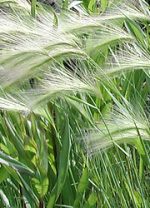
Foxtail barley is a short-lived cool season perennial and a member of the grass family, Poaceae, that also includes corn, bamboo, and rice. It is also known by several other names including bobtail barley, and squirrel tail grass or barley, due to the fluffy appearance of its showy seedheads. Native to North America, foxtail barley is found throughout the US except in the Southeast. Plants prefer full sun and moist to dry soil, and are very tolerant of of salt and alkaline conditions but not of competition from taller vegetation. They grow well in a variety of sites including edges of marshes, muddy borders, river beds, meadows, prairies , fields, pastures, vacant lots, roadsides, edges of railroad tracts, mined land, and waste areas.
Description: With a shallow fibrous root system, foxtail barley forms a clump 1-2 feet tall and has gray-green leaf blades that are 1/8 to 1/4 inch wide and are rough on the upper surface. The flowerhead appears in early summer and is a nodding spike two to five inches long. It is green with reddish or purplish tints before becoming tan and brittle. The awns are sharp, up to two inches long, and have backward pointing barbs so are dangerous for foraging cattle or wildlife. Plants spread primarily by seeds that remain may remain viable in the soil for up to five years.
Control: Although the seed heads of the plants are very attractive and good for the vase, they plants can become weedy and are difficult to eradicate. Pull or dig out seedlings or young plants being sure to remove all the root. Cut or mow large plants before they set seed. Be forewarned, however, mowing and cutting can cause plants to grow more prostrate and continue flowering. Alternatively, cover the whole area with a dense mulch such as newspaper or cardboard. In severe cases, herbicides such as glyphosate, terbacil, metribuzin, pronamide, hexazinone or paraquat are effective, with the choice being dependent on the surrounding vegetation.